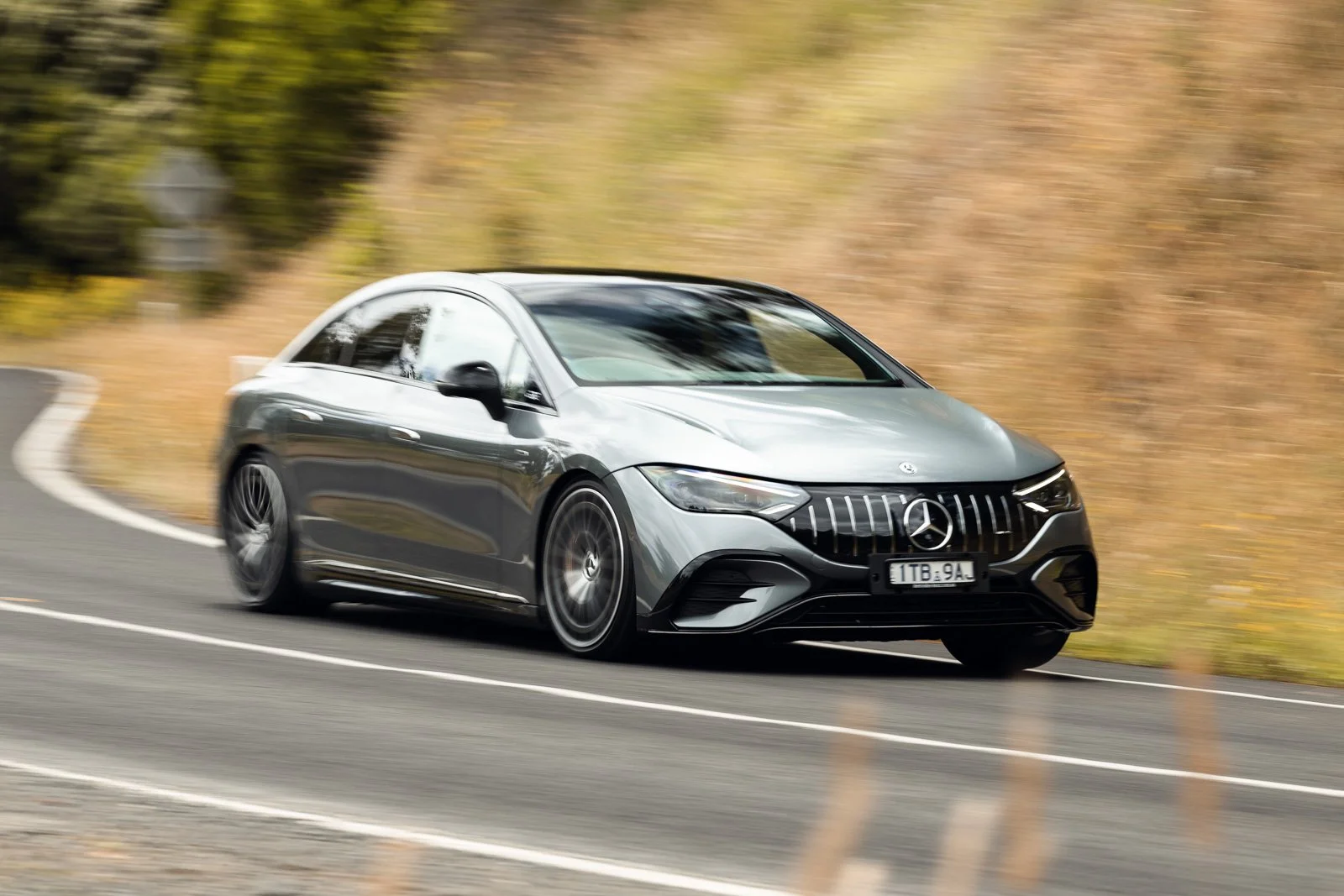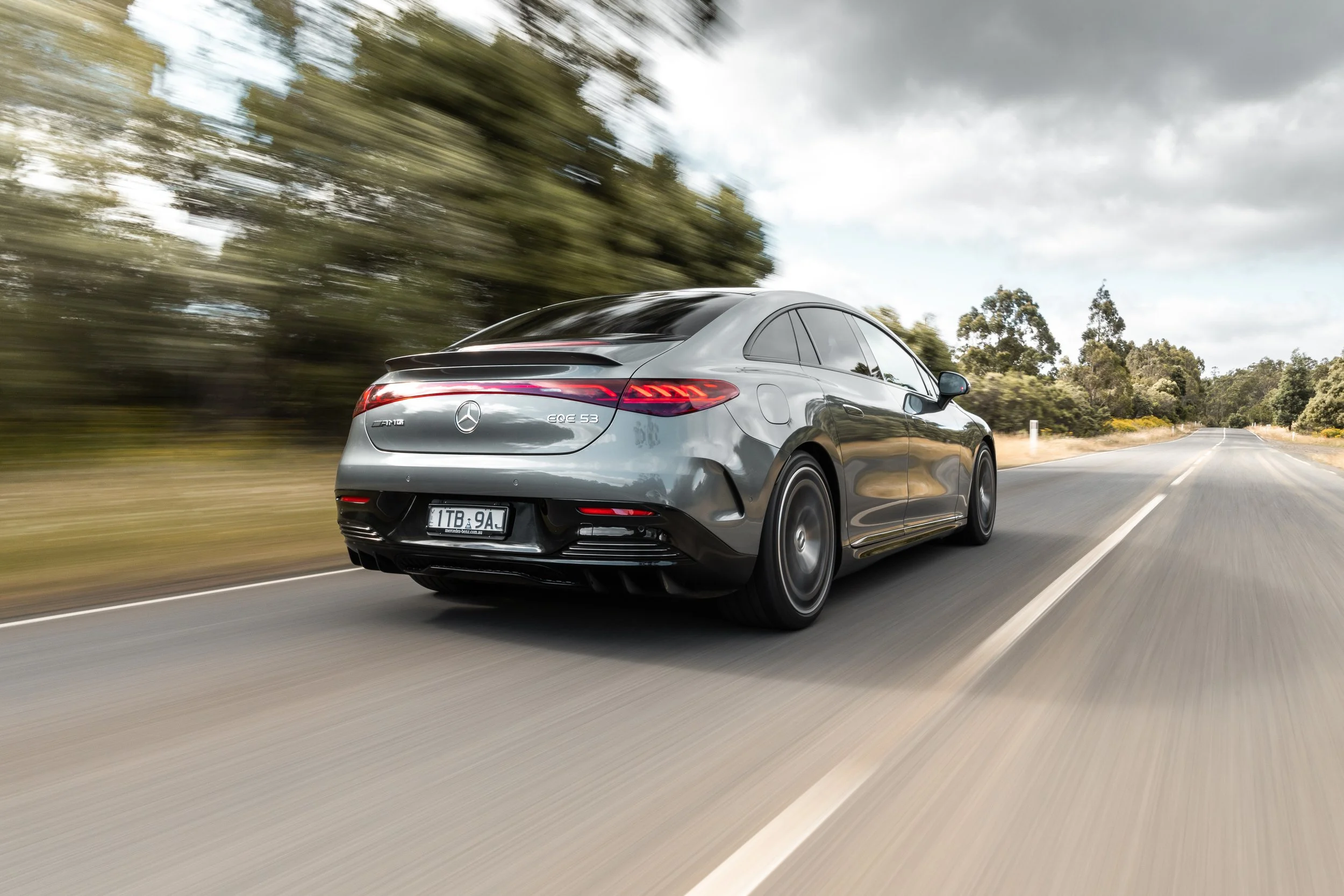Electric ‘E’ lands in NZ
/Three versions of EQE to bolster Benz’ battery-pure push.
THE ‘other’ E-Class, whose designation really does stand for electric – has landed in New Zealand, spanning three versions, including one with AMG tuning.
Simplistically, the EQE is last year’s EQS battery-wed large sedan in a smaller scale.
Same look and with a lot more in common under the skin – much more so than it does with any combustion-engined E-Class. Notwithstanding that Mercedes has overnight announced the latter is adopting a third generation MBUX infotainment layout, called tri-screen, that all but emulates the look and functionality of the ‘hyperscreen’ that made production entry with EQS and provisions to EQE though only as an option on the flagship.
EQE and EQS both use a dedicated EV platform called EVA2. Hence, while the EQE is still a four-door saloon, it has a unique look wholly different to that the Mercedes E-Class, which will continue to stay in circulation.
The line-up, on sale from today, kicks off with a $132,100 EQE 300, in which a 180kW/550Nm single motor drives the rear wheels for a range of 626 kilometres and achieves 0-100kmh in 7.3 seconds, then moves up to a pair of dual motor models – the 215kW/765Nm (560km, 6.3s) EQE 450 4Matic for $145,000 then the – deep breath – 460kW/950Nm Mercedes-AMG 53 4Matic Plus (500km, 3.5s) for $195k.
No questioning Mercedes’ stopwatches, but those range figures being resolved by using the NEDC scale seems odd – the industry has moved on to the rather more accurate WLTP assessment. The latter isn’t a wholly real-world barometer, either, but chances of NEDC results being achieved are even less likely. Still, for the record, Benz has previously said the rear-drive offers a WLTP-tested range of 637km, so who knows really. The drivetrains are all fed by a 90kWh battery.
The relationship with the EQS flagship is clear from the EQE’s black front panel, ‘one-bow’ cab-forward silhouette – a hallmark of the new era bespoke EV family – and short overhangs at the front and rear. Mercedes also refers to the “sensual purity” achieved by minimising joints, transitions and body lines and suggests the EQE shows off its “athletic character” with pronounced rear haunches and wheels ranging in size from 19 inch to 21 inch.
As with the EQS, the EQE has been designed with optimum aerodynamic efficiency in mind. Benz cites it as one of the world’s most aerodynamic vehicles, with its slippery profile registering a drag coefficient of just 0.22.
Mercedes’ claim that this makes it “second only” to the reigning world champion, the EQS 0.20 Cd, can be called out – the car that actually holds that status , by virtue of having a Cd of 0.21, is the Hyundai Ioniq 6, also just about to release here.
When EQS was on test with MotoringNZ.com, everyone seemed compelled to voice an opinion about the look. It’ll be the same with EQE; let’s concur on it being one of the brand’s more interesting cars. Those who admire design would surely also agree the effort into making the EQE as slippery as possible is really impressive.
It has a smooth underbody, there’s been rigorous panel gap sealing and it of course has a closed-off grille. The bonnet is incredibly low to cut through the air, and it's a proper clamshell design, too. Mercedes is even offering specially developed 19in and 20in ‘aero wheels’, including a set with an almost completely closed surface. That it can’t quite match the EQS is as a result of its shorter overhangs and standard-fit multi-link front and rear steel suspension.
Another pub fact if you’re into sharing Green credentials: EQE is the first Mercedes model to be built using 100 percent recycled steel. The manufacturing plant in Bremen, Germany, has been converted to climate-neutral production and takes its electricity exclusively from renewable sources. Production of battery systems for the EQS and EQE, at the Mercedes-Benz plant in Hedelfingen, is CO2- neutral.
The car is 270mm shorter than the EQS, at 4946mm long, and has an 80mm-longer wheelbase than the E-Class, at 3120mm. Mercedes notes that it is more comparable in size to the CLS four-door coupe and, like that car, the EQE has a hatch-style bootlid rather than a sedan-style one.
The minimised environmental footprint doesn’t inhibit it by being luxurious and spacious; it’s flat-floored, of course. Interior space exceeds the comparable Mercedes-Benz E-Class in several dimensions, including interior length (up 80mm) and front shoulder room (up 27mm). Benz says: “The EQE provides comfortable accommodation for up to five people even on longer journeys, whilst the driver-focused cockpit makes it an ideal companion for weekday commuting.”
About the interior. Until today, you would say the car is most differentiated from the conventionally fuelled E-Class by an interior design that’s familiar from the EQS, not least when it configures with the 1410mm-wide ‘Hyperscreen’ infotainment. But that’s not a given.
Spanning the width of the dashboard, this high-definition screen is described as giving “zero layer” access to the key functions of the MBUX operating system, so the user does not need to cycle through multiple menus.
Over-the-air system updates and upgrades are part of the package in Europe. Presumably NZ owners will also be offered enhanced features such as the ‘Roaring Pulse’ sound mode (which gives the option of a “large-volume combustion engine” soundtrack), specially developed driving modes for young drivers and technicians, in-built video games and uprated headlight technology.
However, as said, whereas hyperscreen is standard to EQS, it’s a cost-extra for EQE. Price yet to be disclosed.
The standard instrument panel is a version of the MBUX layout, comprising a traditional instrument binnacle ahead of the driver and a portrait-mounted touchscreen on the centre console. Still functional, but not as flash.
NZ’s coarse chip surfaces cause no end of problems for car makers; Mercedes claim of EQE is that it is one of the best for noise reduction; perhaps it’ll be as was found with EQS – the standard car is quieter than the AMG, simply by virtue of it being on a less sporty suspension and tyre package.
With EQE, a foam coating fills various cavities and insulates the electric motors to reduce wind and drivetrain noise, as do bespoke uprated seals for the door handles, mirrors and windows. There is also a subtle trim element at the base of the A-pillar that reduces noise, improves airflow and helps to keep the side windows clean.
The most obvious rival for the EQE is the Tesla Model S, the car that launched the electric executive class. The Audi e-tron GT might also be considered a rival. Mercedes Benz NZ has not shared volume expectations or said how easy it is to secure stock.
What’s next on the EQ roster? That’ll likely be the EQE SUV. Talk that a name change, with divorce from the whole EQ thing, happening next year seems premature.
It is going to happen … but within the next five years, according to latest reports. That times well with the overall electrification plan. The number of EQ cars has grown rapidly in the past two years and it's this change that will eventually make the EQ badge redundant – since every Mercedes-Benz could well be an EQ car by the next decade.
Aside from EQE and EQS, the local EQ line-up also includes the compact EQA and EQB and the mid-sized EQC SUV and the EQV family van.
The EQ name – which stands for 'electric intelligence' – was first adopted in 2016 with the unveiling of the Generation EQ concept car, which went into production as the EQC in 2018.




















